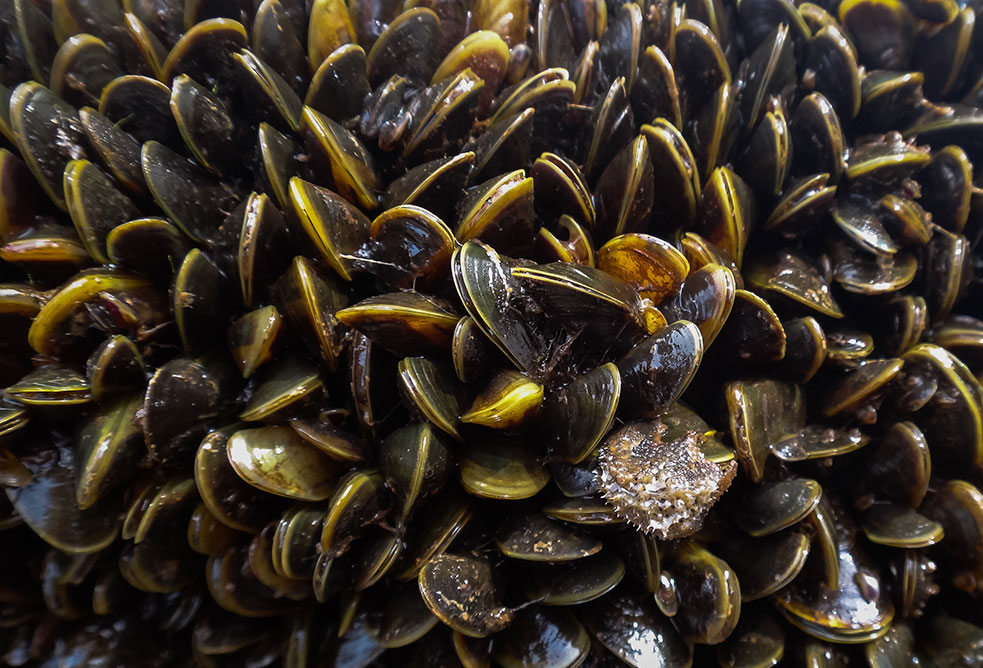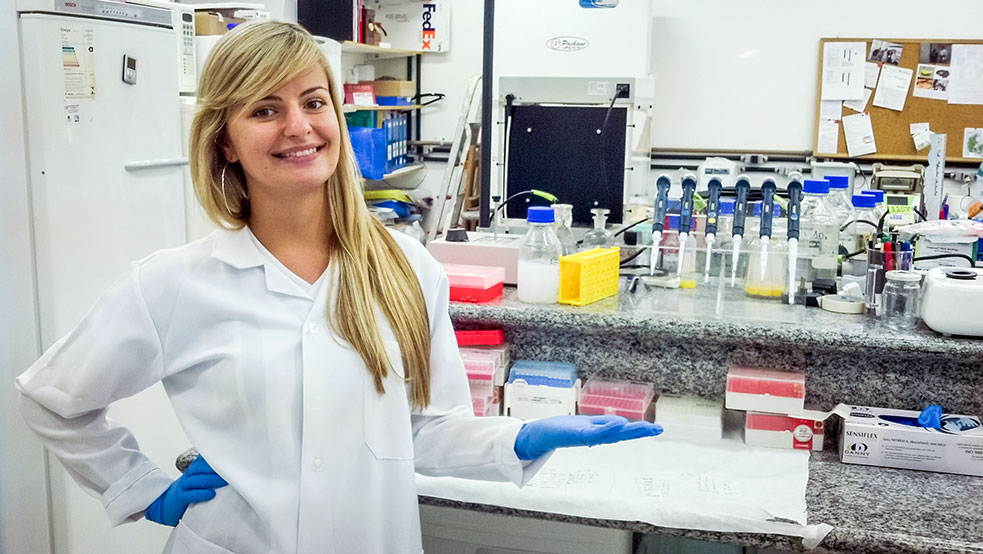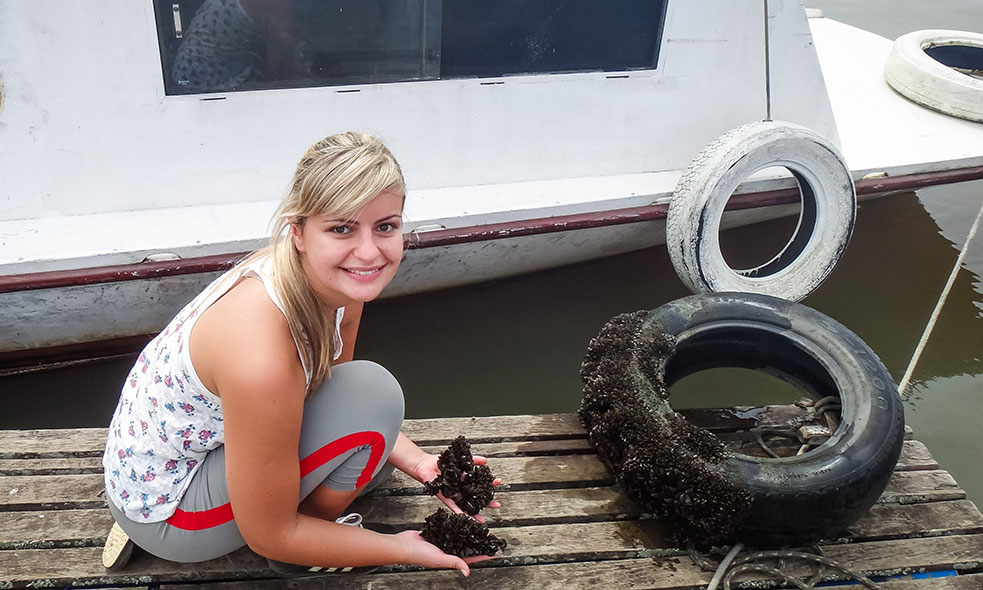Back in the ’90s, the golden mussel (Limnoperna fortunei) hitched a ride on ships traveling from Asia to South America. In the past decade and a half, the mussel has proliferated through South America’s river systems, destroying the native habitat and disrupting the operation of power plants and water treatment facilities. This invasive species now threatens the delicate ecosystem of the Amazon.
Computational biologist and TEDGlobal 2014 Fellow Marcela Uliano da Silva is working to put a halt to this. A native of Brazil, she’s sequencing the golden mussel’s genome for the first time; she tells the TED Blog how she hopes to use information gleaned from its molecular profile to stop current invasions and forecast future ones.
Tell us about the golden mussel — why does it pose a problem to South America?
The golden mussel originates from Asia, and arrived in South America in the early 1990s, carried in ballast water of ships. The first golden mussels were deposited in La Plata estuary in Argentina, and began to spread via the Parana River, going up all the way to the Pantanal wetlands. In these basins, golden mussels reproduced at high rates, fouling and clogging up the pipelines in power plants and water treatment facilities, as well as taking habitat away from native species. The mussels have made their way to Itaipu — one of the biggest power plants in the world — and they also do damage to many power plants in São Paulo and Minas Gerais in Brazil.
But the golden mussel doesn’t only spread via ballast water and larvae that swim upstream — the public play an active role in the invasion, too. There are several famous fishery festivals in the Brazilian wetlands, and people come by car, towing private boats from the south. When they put the boats in the water, they introduce golden mussels to new rivers. That was how it was introduced in the wetlands. That’s why awareness-raising and education are important: we need to avoid introducing mussels in new locations.
How do the mussels affect the native ecosystem?
Scientists are now calling the golden mussel an “ecosystem engineer,” because unfortunately, it changes environments very efficiently. One of its characteristics is that it reproduces a lot, creating huge populations. It’s a filter feeder, so when there are many mussels in one area, water transparency increases. Sunlight penetrates the water more deeply, changing phytoplankton levels and the balance of species living at the surface of the water. In some rivers, there is evidence showing that the fish population has increased 20% because they have a new food resource in the mussels. But when you increase the number of fish, it has a domino effect, as they are at the top of the food chain. Ultimately, when the mussel invades, it transforms the ecosystem, decreasing biodiversity and homogenizing the environment.

Map of the mussel migration. The golden mussel originated from Asia, and was introduced into the river basin systems of South America in the 1990s via ballast water. Today it has proliferated throughout the region’s wetlands and is threatening to reach the Amazon. Image: Julia Back
Are golden mussels a threat to the Amazon?
Yes, definitely, and that is one of our main concerns and reasons for developing a genetics-based solution. The Amazon is the most biodiverse environment in the world. So if the golden mussel gets there, it would modify the environment as it has done in the other basins in South America, unbalancing the ecosystem of Amazon. This would be a disaster.
What’s kept the mussel from reaching the Amazon up to this point?
Beyond the educational campaigns to prevent the spread of hitchhiking mussels, there is a Brazilian regulation in place called NORMAM 20, which makes commercial ships coming to the Amazon deballast twice before entering the Amazon river basin.
The waters of the Amazon basin also vary in their physicochemical characteristics, and to some extent this has helped prevent the golden mussel from establishing itself there. However, the so-called “white” waters — which have nearly neutral pH and a high content of suspended mineral solids — would be friendly to the golden mussel. The waters of the Paraná and the Paraguay and Uruguay basins, where the golden mussels have already spread, have similar characteristics.
Tell us about the paper you recently published. Why is it important?
So my work is to identify the golden mussel’s genetic data, and use our understanding of the mussel’s molecular profile in order to keep it from harming the environment.
The paper, “Gene Discovery through Transcriptome Sequencing for the Invasive Mussel Limnoperna Fortunei,” was the first-ever molecular profile for the golden mussel to be published. Until it came out, there had been virtually no genetic information available for the golden mussel. Our goal was to use the power of next-generation sequencing technology to describe as many genes as possible with a first transcriptome sequencing approach.
We now have around 90,000 expressed sequences for the golden mussel, which allowed us to raise some hypotheses about the relationship between phenotypic plasticity and the success of the mussel as an invasive species and efficient ecosystem engineer.

Close-up of the invasive golden mussel, which proliferates quickly and densely, clogging up power plants, waterworks and destroying ecosystems. Photo: Marcela Uliano da Silva
Can you give us an example of what you’re looking for?
For example, the genome of the oyster Crassostrea gigas, a bivalve like the golden mussel, offered us some insights about what to look for in the golden mussel transcriptome. This oyster has an expansion in some gene families that are expressed to keep the cell alive in moments of stress, like the Heat Shock Protein 70 (HSP70). It has 88 copies of this gene, while humans have only 17. This represents different adaptations of different animal groups, which have different life habits. Our first analyses showed that L. fortunei expresses at least 55 different types of HSP70 isoforms. We’re double-checking its profile now that we are sequencing the genome. But one of our main hypotheses is that the golden mussel likely has a robust genotype, differently expressed in diverse environments, that would give it an advantage in dealing with the challenges of establishing itself in a variety of environments, such as the different basins where it thrives in South America.
So how can you apply the mussel’s molecular profile to actively prevent a future invasion?
Our next step is to sequence the entire genome and understand the golden mussel’s gene expression, so that we can see the ways it copes with various stressors. For example, we plan to expose mussels to a range of temperatures to see which genes express. Studying these profiles, we can find key genes, which may be the future targets for a gene therapy approach.
Through a series of processes, we can develop RNA interference that will keep these genes from expressing — rendering the mussels sterile, for example. Another reason to develop this project is our interest in evolutionary studies. The more genomes we sequence, the better we will be able to understand relationships among the living species. This project is also part of an international collaboration called GIGA, which aims to keep track of groups working in genomics and transcriptomics of invertebrate species around the world.
What if you end up killing off the golden mussel all over the world, even in places where it’s not invasive?
This is a good question. Risk assessment studies have to be done before applying such approach in the wild, no doubt. Each invaded location is different, and we have to do a proper prior study. Nevertheless, new locations and controlled locations, like power plants, could deeply benefit from a gene therapy approach. The idea is to send a vector, like a virus, in controlled concentrations, so it would get to distant water bodies. This vector would contain a specific target for a specific golden mussel gene. This is much more efficient and harmless when compared with chemicals, which kill not only mussels but all the biodiversity around them. Gene therapy using a vector to carry the RNA interference is not like creating a transgenic mussel. We won’t introduce any new genes into the golden mussel genome, so the environmental risk is small.
Is the mussel a threat anywhere else?
Yes. Apart from the impacts to the most biodiverse ecosystem in the world, if the golden mussel crosses the Americas and gets to the United States, ecologists predict it would have a greater impact than the zebra mussel (Dreissena polymorpha), a well-known invasive species in the U.S. and Europe that’s responsible for millions of dollars’ worth of damage.
What else do you need to move forward with this work?
We are moving forward amazingly well, considering the number of people involved in this project. But we still lack ideal computational power. My co-advisor, Dr. Francisco Prosdocimi, has a computer cluster that we use to assemble the genome, but this is a very busy computer, as there are a lot of projects running on it. Our current solution is to do what many other scientists are doing: use the cloud to compute our work. But that also costs money and time. But it seems to me that the future of computer-processing is crowdsourcing.
How would that work?
Nowadays we all have powerful computers in our pockets — our smartphones. At the moment, while people are sleeping and phones are recharging, all that processing power is wasted. Why not use this computing power to help scientific research? There are already some scientific groups that have developed apps to harness this memory. One approach created by a group of researchers in Canada is a computational game. While the remote users are playing the game, they are helping to align gene sequences. So it’s kind of like Tetris.
As a native Brazilian welcoming TED’s first major conference to Brazil, what would you like the TED community to know about your country?
When I think about Brazil, I have mixed feelings. The first feeling is of great love: Brazilians are so tolerant and friendly with people from all over the world, and that makes me feel very proud of our people. I’m also happy that Brazil’s major problem — huge social inequality — has decreased vastly these last 10 years or so. The hurtful part, nonetheless, is that there are still a lot of people without opportunities and living in precarious conditions, which I feel is unacceptable for a rich country like Brazil. And it’s really time for us to find a way to grow our economy in balance and accordance with preserving ecosystems. This is an urgent matter that has been neglected, in my opinion.
All that said, I can really say that TED attendees should look forward to the experience. Brazil, with all its richness and diversity, won’t disappoint you!


Comments (5)